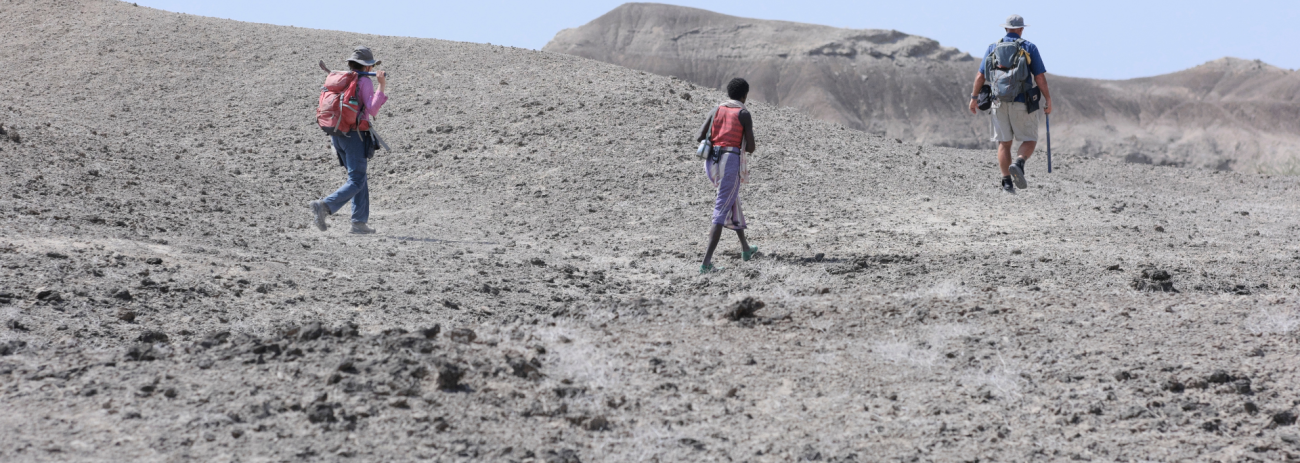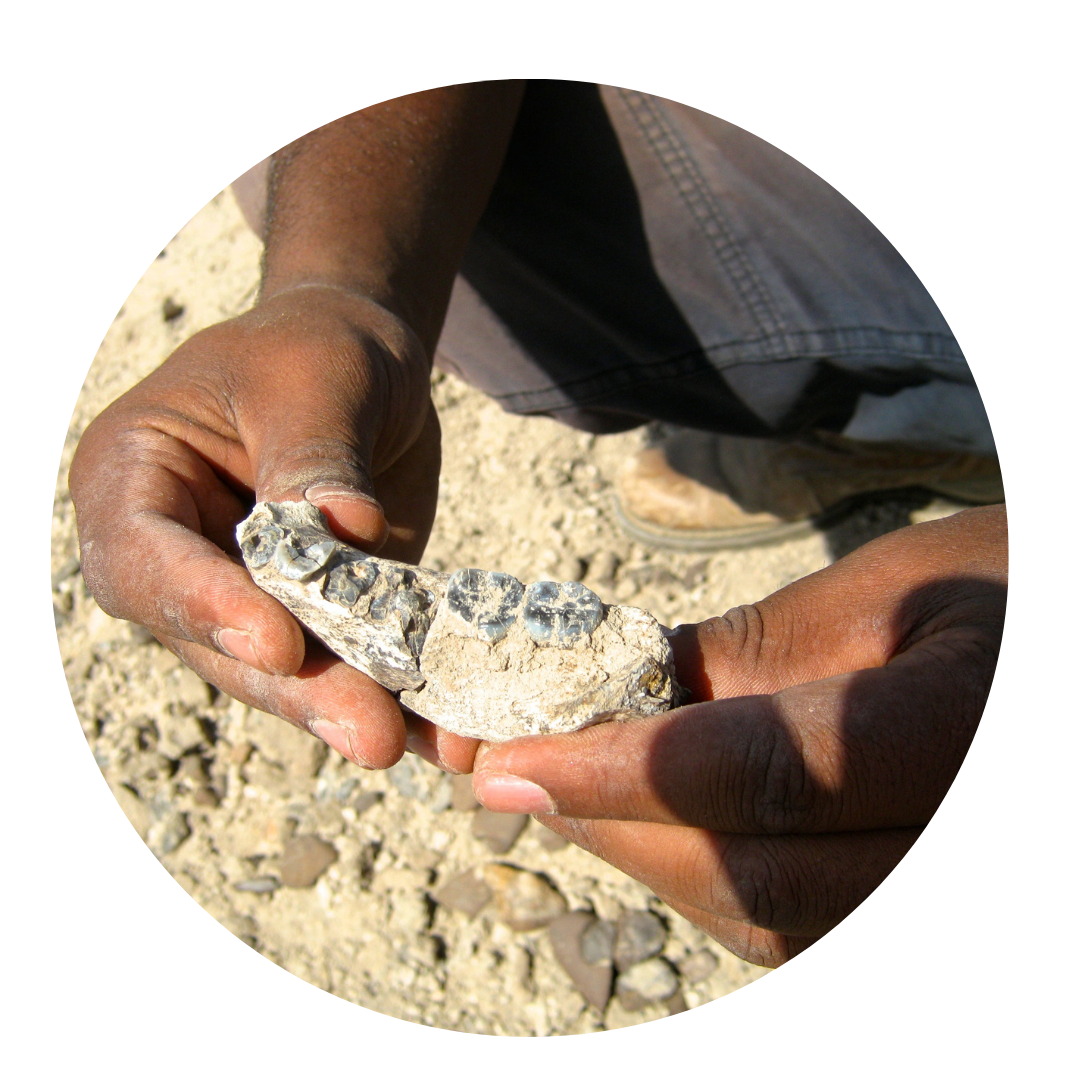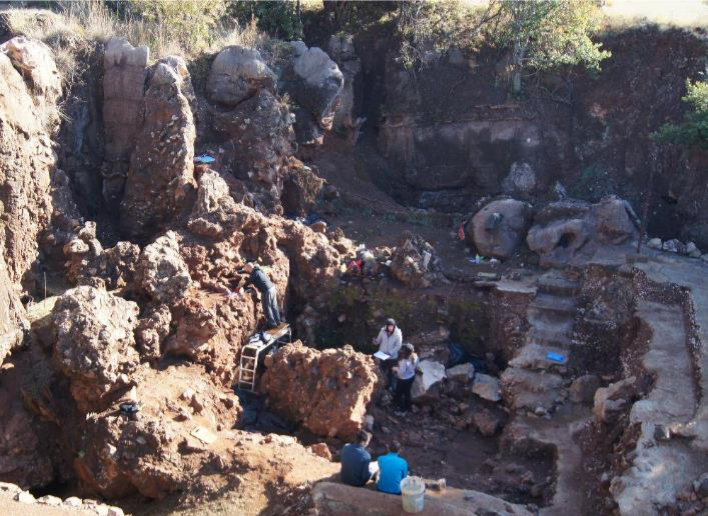
High-Profile Discovery
Searching for our origins—from "Lucy" to the earliest evidence of our own genus, Homo
Fossil Record of the Earliest Human Evolution
IHO began its career focused on the early phases of human evolution (4 to 2 million years) with a field program at Hadar, Ethiopia, along with several other East African field localities. The novel long-term commitment to Hadar continues and has produced an unprecedented understanding of the biology and environment of the early biped Australopithecus afarensis. A recent expansion of this research is the paleolake drilling project to establish high-resolution ancient climate and environment information for early hominin lifeways, and several grants have been awarded/pending for this research.
Ongoing IHO fieldwork at Hadar, Ledi-Geraru, and Woronso-Mille, Ethiopia, as well as other African sites address the evolution and ecology of Australopithecus (3.0–3.4 million years ago) and the origin of Homo and stone-tool making (2.3 million years ago).
Image on right is of a jaw of our own genus Homo, discovered at the Ledi-Geraru site. Photo credit John Rowan.

Research Projects

Drimolen, South Africa
An international team including IHO researcher Gary Schwartz, has unearthed the earliest known skull of Homo erectus, the first of our ancestors to be nearly human-like in their anatomy and aspects of their behavior.
Years of painstaking excavation at the fossil-rich site of Drimolen, nestled within the Cradle of Humankind (a UNESCO World Heritage site located just 40 kilometers or around 25 miles northwest of Johannesburg in South Africa), has resulted in the recovery of several new and important fossils. The skull, attributed to Homo erectus, is securely dated to be 2 million years old.
More about Drimolen:
Hadar Ethiopia
Addresses the early evolution and ecological variation of Australopithecus (3.0–3.4 myr) and the origin of Homo and stone-tool making (2.3 myr). In 2007, this field project began to operate as ASU’s Hadar Field School, which has in three field seasons enrolled 46 undergraduates from ASU and other universities across the U.S. in a rigorous semester-abroad curriculum on field methods in human origins research.
Major Funding
W.M. Keck Foundation ($1,200,000; ASU component = $497,168) “Disentangling the drivers of human evolution: Tectonics, climate, and habitat”. ASU PIs: Y. Haile-Selassie, C. Campisano, D. Feary, K. Reed, D. Su (Case Western Reserve U. as lead institution, 10 additional PIs)
National Science Foundation (BCS-ARCH) ($389,936; ASU component = $108,203) “Collaborative Research: Hominin diversity, paleobiology, and behavior at the terminal Pliocene from Ledi-Geraru (Afar, Ethiopia)”. PIs: R. Arrowsmith (lead), C. Campisano, K. Reed
National Science Foundation (BCS-Biological Anthropology) $311,206 Reconstructing the paleoecological context of major milestones in human evolution: Late Pliocene mammalian fossil assemblages from the Lower Awash Valley (Afar Region, Ethiopia), PI: Yohannes Haile-Selassie, Co-PIs: Kaye Reed, Denise Su.
National Science Foundation (BCS-Archaeology) $134,866. Collaborative Research: Hominin diversity, paleobiology, and behavior at the terminal Pliocene from Ledi Geraru (Afar, Ethiopia) PI: Ramon Arrowsmith, Co-PIs: Kaye Reed, Chris Campisano.
Notable Publications
Mid-Pliocene hominin diversity: New insights from Woranso-Mille, Afar Region, Ethiopia. 2021. Haile-Selassie, Y. In Y. Coppens and A. Vialet (Eds.), Un Bouquet D’Ancêtres. Proceedings of “Premières Humains: Qui Êtait Qui, Qui a Fait Quoi, Ou et Quand?” pp. 83–100. The Pontifical Academy of Sciences, Vatican, Italy.
Human burials at the Kisese II rockshelter, Tanzania. 2021. Laird, M.F., E.A. Sawchuk, A. Kwekason, A.Z.P. Mabulla, E. Ndiema, C.A. Tryon, J.E. Lewis, and K.L. Ranhorn. American Journal of Physical Anthropology.
Earliest known Oldowan artifacts at >2.58 Ma from Ledi Geraru, Ethiopia, highlight early technological diversity. 2019. Braun, D.R., Aldeias, V., Archer, W., Arrowsmith, J R., Baraki, N., Campisano, C.J., Deino, A.L., DiMaggio, E.N., Dupont-Nivet, G., Engda, B., Feary, D.A., Garello, D.I., Kerfelew, Z., McPherron, S.P., Patterson, D.B., Reeves, J.S., Thompson, J.C., Reed, K.E. Proceedings of the National Academy of Sciences 116, 11712-11717. https://doi.org/10.1073/pnas.1820177116
A 3.8-million-year-old hominin cranium from Woranso-Mille, Ethiopia. 2019. Haile-Selassie, Y., Melillo, S.M., Vazzana, A., Benazzi, S., and Ryan, T.M. Nature, 573, 214–219. https://doi.org/10.1038/s41586-019-1513-8.
Age and context of mid-Pliocene hominin cranium from Woranso-Mille, Ethiopia. 2019. Saylor, B.Z., Gibert, L., Deino, A., Alene, M., Levin, N.E., Melillo, S.M., Peaple, M.D., Feakins, S.J., Bourel, B., Barboni, D., Novello, A., Sylvestre, F., Mertzman, S.A., and Haile-Selassie, Y. Nature, 573, 220–224. https://doi.org/10.1038/s41586-019-1514-7.
The evolutionary history of the human face. 2019. Lacruz, R.S., Stringer, C.B., Kimbel, W.H., Wood, B.A., Harvati, K., O’Higgins, P., Bromage, T.G., Arsuaga, J-L. Nature Ecology and Evolution, 3: 726-736. https://doi.org/10.1038/s41559-019-0865-7